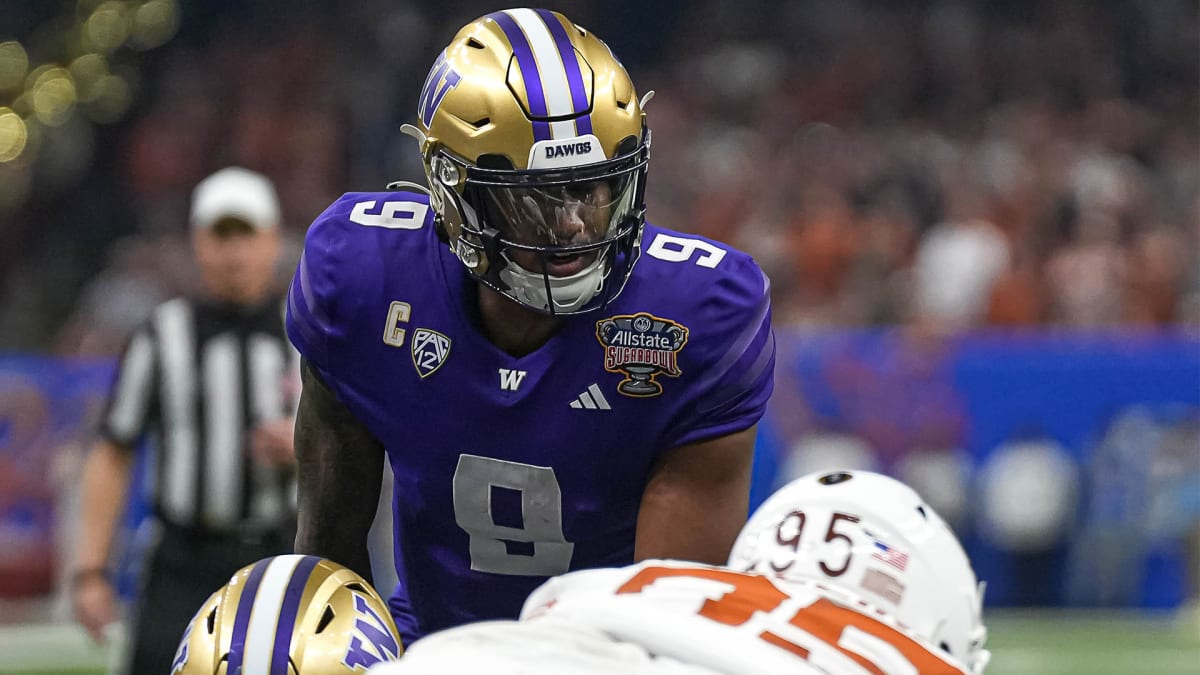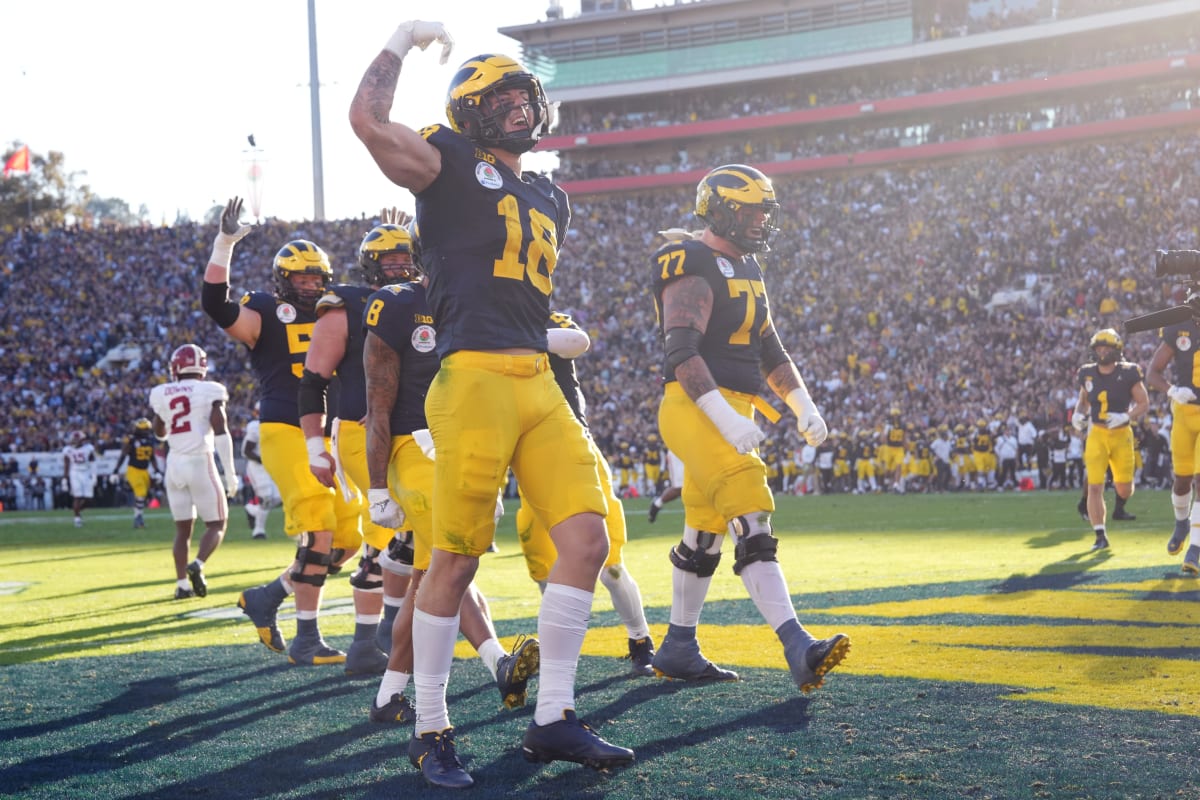For the recruiting industry, the College Football Playoff championship game matchup of the Michigan Wolverines and Washington Huskies on Monday night represents a bit of a crisis. The Wolverines and Huskies shouldn’t be here. This doesn’t compute.
The established formulas for projecting how good recruits will be—and how many of them each team has—are largely at odds with this reality. Michigan and Washington’s rosters are made up of what was rated as good, but not elite, talent. They are reminders that recruiting is inexact and quantifying it is elusive.
In addition, these two teams may serve as bellwethers of a shift in how champions are built. The get-old, stay-old method of roster building has taken over college basketball, and it could be coming to college football now as well.
The 247 Sports “team talent composite” for 2023 ranks Michigan’s roster No. 14 in the nation based on high school recruiting rankings. It ranks Washington No. 26. Since that team talent metric debuted in 2015 at 247 Sports, every national champion has ranked in the top 10 and all but one (2016 Clemson) ranked in the top six.
The schools that have annually dominated recruiting rankings in recent years— Alabama, Georgia and Ohio State—rank first, second and third in the 247 Sports formula for this season. They’ve also combined to win six of the nine College Football Playoff titles and earn 15 playoff bids. But they’ll all be spectators Monday night.
The recruiting outliers have been gaining ground in recent years. While Georgia won the title last season, TCU crashed the final with a team talent ranking of 32. The Horned Frogs got there by beating a Michigan team with a talent ranking of 13. In 2021, Cincinnati dropped in from the clouds with what allegedly was the No. 54 roster in the sport (but nine players ended up being drafted). Michigan was the 15th-ranked team.
So how have the Wolverines and Huskies done it this year? A variety of ways: a savvy eye for underrated players; an acumen for developing and utilizing them upon arrival on campus; retaining veterans who could have transferred or gone pro, but chose to stay in school for fourth, fifth and even sixth seasons thanks to the extra pandemic season of eligibility and/or NIL compensation; productive use of the transfer portal; and schematic coaching advantages.
The sixth-year players will be rinsed out of the system soon. But all the other elements remain in place for what could be the new paradigm of championship program building.
The NFL likes Washington’s talent on its way out much more than the recruiting services liked it on the way in. A team with zero five-star recruits and nearly twice as many three stars (49) as four stars (27) now has four players who are considered potential first-round NFL draft picks: quarterback Michael Penix Jr., wide receiver Rome Odunze, defensive end Bralen Trice and offensive tackle Troy Fautanu. None was a national Top 100 recruit according to either Rivals or 247.
Odunze was the highest-rated prospect of that group at No. 135 in the class of 2020, per 247, while Fautanu was No. 214 in the class of 2019. Trice (No. 612 in that class) and Penix (No. 1,113 in the class of 2018) were three-star prospects.

Aaron E. Martinez/American-Statesman/USA TODAY NETWORK
Odunze, Trice and Fautanu went to Washington and stuck out multiple coaching changes. Trice and Fautanu played their first season for Chris Petersen, then two lean years with successor Jimmy Lake, and the last two for Kalen DeBoer as part of a program renaissance. Odunze committed to Petersen and began his college career under Lake.
“There’s a lot of people that get reality checks really fast in college,” Fautanu said, and that included himself. After redshirting in 2019, he was exclusively a backup in ’20 and then started just three games in ’21. It wasn’t until DeBoer and his staff arrived that Fautanu was able to break into the starting lineup on a permanent basis.
Part of the reality check for the new Washington coaches in their first winter conditioning drills of 2022 was realizing how much talent they were inheriting—regardless of recruiting rankings—and starting with the offensive line.
“I can remember talking with (offensive coordinator) Ryan Grubb and watching the offensive line and being like, ‘Man, these guys are athletic and they’re huge,’“ DeBoer recalled. “We’re like, ‘How can we not have success with these guys out here on this roster?’”
They needed one thing to bring it together: a quarterback. That’s where the portal provided Penix, who had flourished at Indiana with DeBoer as his offensive coordinator and then languished through injuries and a crisis of confidence after DeBoer departed to be the head coach at Fresno State. When he showed up in Seattle in 2022, Washington had all the pieces for an 11-2 breakthrough season.
And then almost all those pieces came back for a run at a national title in ’23. Penix and his receivers—Odunze, Ja’Lynn Polk, Jalen McMillan—could have gone pro and been drafted, but not as high as they will be now. Same with Fautanu, who said he got a third-round draft grade last season. NIL opportunities weren’t the overriding factor, but they helped make the decisions a little easier.
Washington added one more key offensive piece via the portal for this season in running back Dillon Johnson, who arrived from Mississippi State. (That pickup that became vital when Cameron Davis, a career 900-yard rusher, was lost for the year with a preseason injury.) Johnson described his new team as “loaded,” and the Washington coaches quietly agreed.
Confidence was high enough that Grubb contemplated making the national championship the stated goal for his unit before the season. He had an idea— start every Sunday meeting with a projection slide of the CFP trophy and a countdown of the number of days until Monday, Jan. 8, the day of the title game. Grubb ran the idea past Petersen, the former Washington coach, who raised a concern—if the Huskies lose, they have to change the message.
Grubb thought about it and made his decision.
“Screw it, we’re going for it,” he said, opting to use the countdown. “Like fourth-and-1 in the Apple Cup, right?”
That was the final part of taking good to great at Washington. They had talented players who had developed and improved. They kept the nucleus around, becoming older and wiser. And they empowered them with a fearless approach to the game.
Nothing illustrated that more than the Grubb/DeBoer collaborative decision to go for the fourth-and-1 at their own 29-yard line with 1:14 left in a tie game with rival Washington State. The Huskies were 11-0 at that point with a season’s worth of dreams on the line. The conventional coaching wisdom screamed to punt the ball and play defense, because coming up short would immediately put the Cougars in range for the winning field goal. But Grubb wanted to go for it and DeBoer signed off.
Grubb didn’t just call a dive into the line of scrimmage. He called a jet sweep to Odunze off a fake by Penix, a jaw-dropping gamble that resulted in a 23-yard gain. A few plays later Washington kicked the winning field goal to keep its championship quest on track. Six weeks after that, a team with nine sixth-year players is on the cusp of a championship.
For Michigan, the recruiting classes have been higher ranked than Washington, but still below the top ones—particularly arch-rival Ohio State and the team the Wolverines defeated in the Rose Bowl to get here, Alabama. That victory led to some exaggerated proclamations from Michigan players about being a team of “no-star recruits,” which doesn’t mesh with the facts: per 247, the Wolverines have two five-star players (junior quarterback J.J. McCarthy and sophomore cornerback Will Johnson), 45 four-star players and 38 three-stars.
But there is no denying the fact that some of Michigan’s most important parts were relatively small fish in the recruiting sea. That starts with defensive back Mike Sainristil, who arrived as a three-star wide receiver from Everett, Mass., but switched sides of the ball and has become a versatile wrecking ball of a defender.
“We have a lot more three-stars and two-stars than five-stars, so when you’re able to develop (players), it’s important,” Sainristil said. “Development isn’t just what you do on the field, it’s how well you know the game, your knowledge of football. When you have a bunch of guys who know football well, it creates a very good football team. I feel like that’s what we have here."
Michigan’s No. 2 tackler, Michael Barrett, and No. 3 tackler, Ernest Hausmann, were three-star recruits. So was linchpin defensive tackle Kris Jenkins. Most of them have played a lot of football, too: Barrett is 24, Sanristil is 23 and Jenkins is 22.
“When you have an experienced team, you have more leadership,” Sainristil said.
On the offensive side, eight out of 11 Michigan starters are at least 22 years old. Most of them were around for the grim 2020 season in which the Wolverines went 2-4 amid the pandemic. The Buckeyes owned the Wolverines then, coach Jim Harbaugh was on the hottest of seats and the aura around the program was not good.

Kirby Lee/USA TODAY Sports
“Our team was so mentally weak that COVID year,” offensive lineman Trevor Keegan said. “It took a toll on everybody. Guys who have been here since 2020 saw how horrible it was. When we were losing, going to Schembechler Hall every day was a drag. It was awful. It was a bad time, there was just this dark aura. After that season, we went to work.”
Part of the work was implementing a daily “Beat Ohio” drill in practice. It could basically be described as a brawl in pads.
“That wasn’t even football, it was just gladiator-like ... no technique, nothing,” Keegan said. “I think that really changed the script of our program.”
Lo and behold, Michigan has indeed beaten Ohio State every year since then. And now the Wolverines have won a playoff game after two straight losses. Beating all those five stars who play for the Buckeyes and Crimson Tide—a combined 28 of them, according to 247—means something.
“The blueprint we have is special,” Keegan said. “We don’t get five-star guys—people say Michigan can’t recruit five-stars. Well, we have guys with heart, guys who love football, guys who love Michigan. That’s special.”







